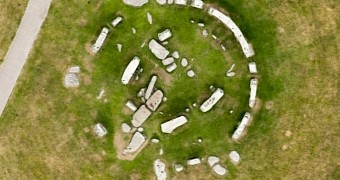A recent paper in the journal Antiquity documents the discovery of several fairly bizarre patterns in the ground surrounding Stonehenge. These patterns are believed to have been created by massive rocks, and indicate that the monument was once a complete circle.
What's interesting is that it was not archaeologists or historians who discovered that this world-famous monument was not always a semicircle. On the contrary, it was a groundskeeper who first noticed the patterns that hint at Stonehenge's initial shape.
Even weirder, the groundskeeper was not even looking to rewrite the history of this monument when he found them. On the contrary, he was merely doing his job watering the grass surrounding this monument in Wiltshire, England.
As detailed in the journal Antiquity, the garden hose that this groundskeeper was using to water the grass was too short to reach Stonehenge's far side. The result was that part of the ground in the monument's proximity fell victim to a prolonged drought in the region. Huffington Post tells us that, while looking at this parch of scorched land, thinking how best to deal with the problem and properly water it, the groundskeeper noticed the bizarre patterns in the ground. He eventually started thinking that there was more to these patterns than one would first assume.
“I was standing on the public path looking at the grass near the stones and thinking that we needed to find a longer hosepipe to get the parched patches to green up,” groundskeeper Tim Daw told the press in a recent interview concerning his find.
“A sudden lightbulb moment in my head, and I remembered that the marks were where archaeologists had looked without success for signs that there had been stone holes, and that parch marks can signify them. Not being archaeologists we called in the professionals to evaluate them,” he added.
Sure enough, archaeologists called in to have a look at the patterns confirmed Tim Daw's suspicions that their presence in the ground surrounding Stonehenge was evidence that in its early days, this monument was a complete circle. How and why it lost some of its stones remains a mystery.
The patterns observed by the groundskeeper and later on analyzed by specialists are visible in the photo accompanying this article. In this picture, they are located in the lower left of the monument. Thus, it is the patches of yellowed grass that specialists suspect that once accommodated for massive stones that were part and parcel of Stonehenge.
The news that Stonehenge was likely a full circle in its early days comes shortly after one other team of researchers announced that, according to evidence obtained with the help of ground-penetrating radar technology, several previously undocumented monuments might be lurking under this prehistoric rocks complex.

 14 DAY TRIAL //
14 DAY TRIAL //